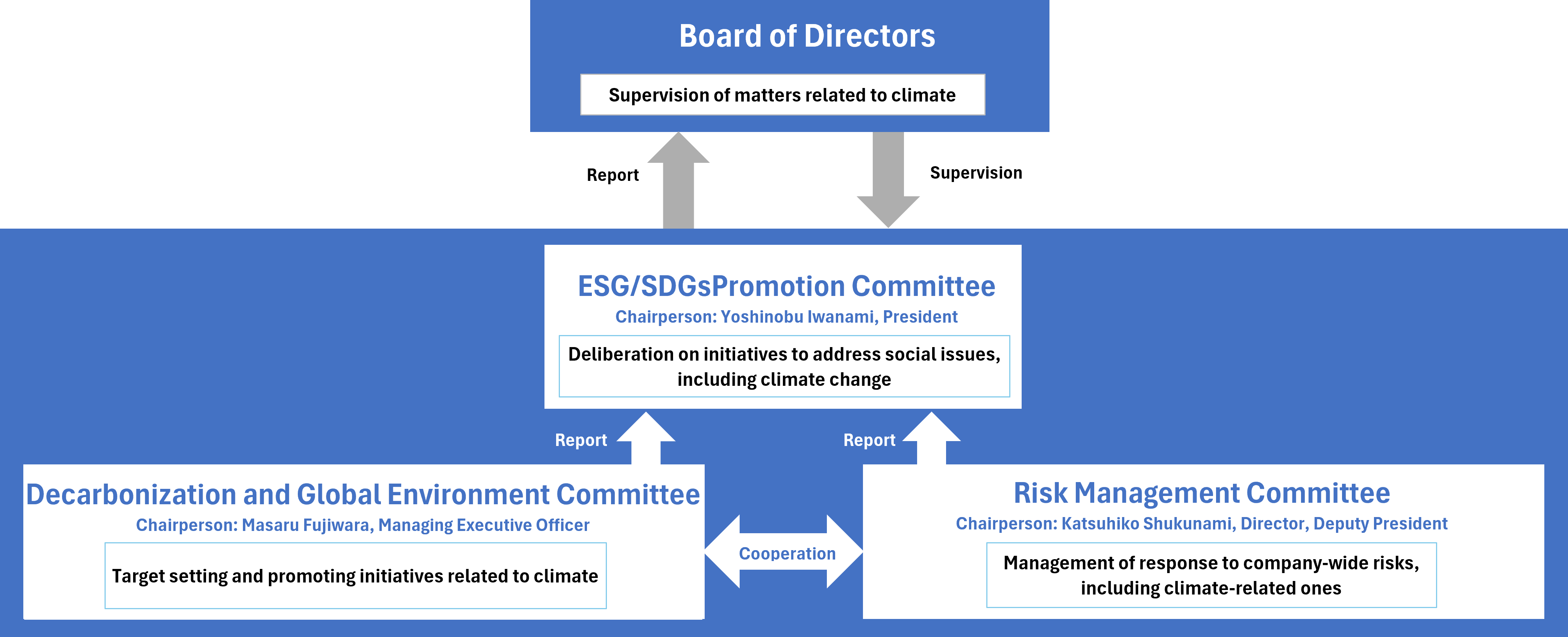Information Disclosure based on the TCFD recommendations
The scope and extent of the impact of climate change on the global environment and civic life are expanding, such as frequent and severe storm and flood damage and destabilization of energy markets. The role that companies should play in mitigating and adapting to climate change is becoming increasingly important, and we consider climate change to be an important social issue. Decarbonization/carbon neutral initiatives are being quickly rolled out by our customers and in markets as well. As the demand for semiconductors, which are indispensable for conversion to new clean energy and higher efficiency of energy use, is expected to increase, we hope to further contribute to the decarbonization of the market and society through our technologies and products. Based on this recognition and thought, we believe that meaningful dialogue is important with our stakeholders regarding the impact of climate change-related risks and opportunities connected to our business, strategy, and finance, and disclose our system and initiatives based on the TCFD recommendations.
Governance
■Positioning of Climate Change Issues
The Group recognizes climate change as one of the most important social issues, and in 2022, we signed up as a supporter of TCFD.
As the role of companies in mitigating and adapting to climate change becomes increasingly important, we have set decarbonization and energy conservation as our first materialities.
With a view to this mitigation and adaptation, and following a resolution by the Board of Directors in fiscal 2021, we began disclosing information based on TCFD recommendations, and we have established the following medium- to long-term goals.
- • Goals for Scope 1 and 2 emissions in the entire Group.
- ⁃Reduction of at least 50% in CO2 emissions by FY2030 compared to FY2023
- ⁃Virtually zero CO2 emissions by FY2050
- •Increase sales of products that contribute to realizing a decarbonized society to approximately 6 billion yen in FY2030.
■Governance System
The Group has established the ESG/SDGs Promotion Committee as a high-level organization for addressing issues relating to sustainability, including climate change. Regarding the latter, basic policy and the setting of goals formulated by the Decarbonization and Global Environment Committee, which is a lower level organization, are being deliberated, and we are monitoring progress toward achieving those goals.
Board of Directors’ Supervisory Responsibilities
The Board of Directors regards climate change as an important management issue and has the following supervisory responsibilities.
- • Final approval of climate change strategy and goals
- • Monitoring and supervision of climate-related risks and opportunities
- • Regular reviews of progress with the Company’s response to climate change (twice yearly)
- • Approval of climate change-related investment decisions
ESG/SDGs Promotion Committee
The President acts as chairperson of the ESG/SDGs Promotion Committee, and has ultimate responsibility and authority in matters related to climate change. The committee comprises chairpersons of sustainability-related committees and managers from principal corporate divisions, and makes it possible for us to address climate change from a company-wide perspective. In principle, the committee meets quarterly and the matters it deliberates are regularly reported to the Board of Directors.
The committee’s role in relation to climate change includes the following matters.
- • Formulating and promoting sustainability strategy, including climate change strategy
- • Monitoring the management status of climate-related risks and opportunities
- • Monitoring the establishment and progress of climate change goals
- • Company-wide decision-making regarding our response to climate change, etc.
Decarbonization and Global Environment Committee
The Managing Executive Officer is chairperson of the Decarbonization and Global Environment Committee, which comprises representatives from each business division. The committee has the following responsibilities.
- • Setting climate change-related goals
- • Collecting, analyzing, and assessing climate-related data
- • Promoting and coordinating the response to climate change at each business division
- • Identifying climate change risks and opportunities and considering countermeasures
This committee meets quarterly, and the details and progress of its activities are reported to the ESG/SDGs Promotion Committee.
Risk Management
■Risk Management System
The Group’s climate-related risk management is primarily implemented by the Decarbonization and Global Environment Committee. This committee is responsible for identifying, assigning, and monitoring climate change-related risks and opportunities, and it reports quarterly to the ESG/SDGs Promotion Committee.
Overall and integrated risk management is overseen by the Risk Management Committee, which builds and operates a company-wide risk management system that also covers climate-related risks. These two committees coordinate closely with each other, with the aim of making our response to climate change more effective.
Risk Management Committee
The Executive Vice President acts as chairperson of the Risk Management Committee, which comprises heads of each business division. The committee has the following responsibilities for promoting stronger risk management.
- • Regularly identifying, analyzing, and assessing material risks and formulating risk countermeasures
- • Regularly reviewing risk countermeasures and considering steps for revising them
- • Examining countermeasures and measures for preventing the recurrence of material risks, should they become apparent
- • Reporting to the Board of Directors
This committee meets on a quarterly basis and reports to the ESG/SDGs Promotion Committee, for example, on matters such as climate-related risk management and progress.
■ Identification, Assessment, and Management Processes for Risks and Opportunities
Identification and Assessment Process for Risks and Opportunities
At least once a year and led by the Decarbonization and Global Environment Committee, the Group undertakes a sequential process from reviewing to identifying material climate-related risks and opportunities.
Based on the latest information from inside and outside the Company, such as trends in international policies and regulations related to climate change, industry trends, technological innovations, and climatic and weather conditions, this process initially involves identifying risks and opportunities in the entire Group and throughout the value chain.
Having been identified, these risks and opportunities are assessed and summarized from three perspectives: degree of impact, timing of occurrence and/or realization, and likelihood of occurrence and/or realization. We consider the assessment results overall, and identify those items that significantly impact the Group’s business strategy and financial planning as material risks and opportunities.
Monitoring Risks and Opportunities
Having been identified, material climate-related risks and opportunities are monitored in a timely fashion by the Decarbonization and Global Environment Committee, based on KPIs such as CO2 emissions, sales of environmental contribution products and services, and progress with investments for addressing climate change. The results of this monitoring are reported quarterly to the ESG/SDGs Promotion Committee, which reviews countermeasures as necessary.
Integration with Company-Wide Risk Management Processes
Following cooperation and discussion between the Risk Management Committee and the Decarbonization and the Global Environment Committee, climate-related risks and opportunities which have been identified as material are integrated in company-wide risk management processes. Climate-related material risks are incorporated in a company-wide risk map, and risk countermeasures are reflected in the Medium-Term Management Plan and fiscal year business plans. Conformity with company-wide sustainability strategy is maintained through regular reporting to the ESG/SDGs Promotion Committee.

Strategy
Based on the aforementioned risk management systems and processes, the Group is strengthening its analysis and handling of material climate-related risks and opportunities, and improving the disclosure of related information.
■Future World View
In identifying climate-related risks and opportunities that may affect our business, strategy, and finance, we summarized our views of [1] a world where decarbonization progresses and temperature increase is limited to a range of 1.5°C to 2°C, and [2] a world where global warming progresses with a temperature increase of 3°C to 4°C as a natural consequence. We then extracted and sorted out climate-related drivers in each scenario that are likely to exert a large impact on our company.
[Future World Views and Major Climate-Related Drivers]
| Future world views | [1] 1.5°C - 2°C Scenario (Decarbonized society) | [2] 3°C - 4°C Scenario ("Let it ride" society) | |
|---|---|---|---|
| A scenario in which social changes associated with the transition to a decarbonized society affect our business | A scenario in which climate change mitigation measures turn out to be unsuccessful, allowing global warming to progress as a natural consequence and affect our business | ||
| Ambitious policies and innovation of environmental technologies can be implemented to control the average temperature increase before the end of this century to between 1.5°C and 2°C and to achieve sustainable development. | Although each country implements policies to achieve its target in line with the Paris Agreement, international cooperation, environmental technology development, energy conversion, etc. turn out to be insufficient, and the average temperature increase until the end of this century will be approx. between 3°C and 4°C. | ||
| Major climate-related drivers | Policies / Regulations | •Global carbon pricing and carbon price increase | •Carbon price remains low |
| Market | •Spread of autonomous driving •Increase in demand for semiconductors in conjunction with advances in communication and information processing technologies |
||
| •Increase in demand for semiconductors in conjunction with advances in communication and information processing technologies | •Continued dependence on fossil fuels, soaring fossil fuel prices •Continued operation of thermal power plants •Continued sales of vehicles equipped with internal combustion engines |
||
| Technology | •Intensifying competition for technological development toward a decarbonized society Progress in the development of CCUS※1 technology, increase in CO2 transfer volume |
─ | |
| Changes in weather and climatic, environment | ─ | •Frequent and severe flood damage •Depletion of water resources and deterioration of water quality |
|
| Main reference scenario | IEA※2NZE IEA APS IPCC※3RCP 2.6 |
IEA STEPS IPCC RCP 8.5 |
|
※1 CCUS:Carbon dioxide Capture, Utilization and Storage
※2 IEA: International Energy Agency
※3 IPCC: Intergovernmental Panel on Climate Change
■Identifying Important Risks and Opportunities
The PILLAR GROUP identifies material risks and opportunities as follows.
Timelines are defined as short term (up to 3 years), medium term (from 3 to 10 years), and long term (more than 10 years).
[Risks]
| Details of risks | Time axis | Measures against risks | |
|---|---|---|---|
| Policies / Regulations | Burden of carbon price according to the amount of GHG emissions of the company | Medium term | Reduction of GHG emissions by promoting energy-saving and energy-creating initiatives |
| Market | Decrease in demand for fluid control equipment in the electricity and energy markets as the use of alternatives to fossil fuels is promoted | Medium to long term | Monitoring trends in energy shifts and EV shifts, and strategic response |
| Decrease in demand for fluid control equipment for vehicles equipped with internal combustion engines | Short to medium term | ||
| Technology | Intensifying competition for technology and product development toward a decarbonized society | Medium term | Acceleration of research and development of technologies and products considering environmental load reduction, such as energy saving, resource saving, and space saving |
| Changes in weather and climatic, environment | Occurrence of floods in and around the company's main business sites | Short term | Promotion of measures for disaster preparedness at high-risk sites, strengthening of cooperation between sites, and review/strengthening of BCP |
[Opportunities]
| Details of opportunities | Time axis | Measures to seize opportunities | |
|---|---|---|---|
| Market | Increase in demand for semiconductor-related products along with the progress in digital transformation (DX), etc. aimed to improve the efficiency of socio-economic activities | Short term | Technological innovation and monitoring trends in the information, communication and control markets, and new product launch in a timely manner |
| Increase in demand for fluid control equipment in the clean energy market, such as hydrogen, ammonia and biomass fuels | Medium to long term | Understanding needs and promoting development in the clean energy fluid market | |
| Increase in demand for semiconductor-related products resulting from increased solar power generation and spread of dispersed power sources | Short term | Stable supply of semiconductor and liquid crystal related products for the electric power market in light of the expansion of the renewable energy market and shift to a dispersed energy society | |
| Increase in demand for semiconductor-related products in conjunction with increase in in-vehicle semiconductors and devices for EVs and self-driving cars | Short term | Understanding needs and promoting market development along with the mobility shift | |
| Technology | Increase in demand for fluid control equipment that contributes to CO2 transportation/transfer and fluid control. | Medium term | Acceleration of R&D until the commercialization of CCUS, participation in verification tests, etc. |
| Changes in weather and climatic, environment | Increase in demand for drainage facility and pump-related products | Short term | Operating business that solves social issues |
| Increase in demand for seawater desalination and water purification related products | Long term |
■Risks/opportunities that are expected to be prominent in the following scenarios
- 1.5°C-2°C Scenario
- 3°C-4°C Scenario
■Time axis (timing of manifestation/realization)
Short term: within 3 years, Medium term: over 3 years and within 10 years, Long term: over 10 years
■Scenario Analysis
Among the risks and opportunities that were identified, we took into account their impact on future business (financial impact, etc.) and their relevance to business strategy. We then conducted scenario analysis of the following themes.
Theme 1: The impact of the EV shift on products for the automotive market
Theme 2: The impact of the shift to clean energy on products for the petroleum refining and chemical markets
■Business Strategy Based on Scenario Analysis
The results of scenario analysis enabled us to recognize that the shift to EVs and clean energy is having a significant impact on the Company’s products. However, we also came to understand that actively promoting our response to climate change can lessen this impact and lead to generating and expanding sales opportunities in new markets.
Going forward, we will continue to develop new products and improve the performance of existing ones. By also strengthening our relationships with business partners, we are making the Company more resilient to climate change. Specifically, we are promoting the following initiatives.
- • Accelerating development and expanding sales of environmental contribution products
- • Technological and market development of products aimed at the clean energy market
- • Promoting reductions in CO2 emissions from the Company’s business activities
- • Strengthening our initiatives for reducing GHG emissions throughout the supply chain
- • Strengthening our response to physical risks due to climate change (reviewing BCPs, etc.)
Via these strategies, we will respond appropriately to the risks brought about by climate change, generate new business opportunities, and achieve sustainable growth.
Indicators and Targets
■Goals for Reducing Greenhouse Gas Emissions
With a view to mitigating climate change, the Group is actively working to reduce greenhouse gas emissions, for example, through energy-saving activities, and through in-house power generation from solar power facilities on Company-owned sites.
We have reviewed our goals during fiscal 2024 and formulated more effective reduction plans. During this review, we changed the reference year from fiscal 2013 to fiscal 2023, and we have adopted the approach of the Science Based Targets initiative (SBTi). In order to contribute to the realization of a decarbonized society, we will continue to promote initiatives with the following goals, and while taking into account the Paris Agreement and Japanese government policy.
| Reference year: | FY2023 (14,861 t-CO2) |
|---|---|
| Short-term goal: | Reduction of at least 25% in CO2 emissions by FY2025 compared to FY2023 |
| Medium-term goal: | Reduction of at least 50% in CO2 emissions by FY2030 compared to FY2023 |
| Long-term goal: | Virtually zero CO2 emissions by FY2050 |
With a view to attaining these goals, we are using a combined approach that includes the greater promotion of energy-saving activities, expanding the introduction of renewable energy, streamlining production processes, and utilizing carbon offsets. We regularly evaluate progress and take additional steps where appropriate.
Obtaining Third-Party Verification
In order to improve the reliability of sustainability disclosure information, the Group is obtaining third-party verification for some environment-related performance indicators.
Please see our Sustainability Data Book 2024 for a report (Environment Information Verification Report) covering the period from April 1, 2023 to March 31, 2024.
■Senior Management Incentives
Linking Remuneration with Climate-Related Goals
In order to accelerate initiatives for addressing sustainability issues that include our response to climate change, since fiscal 2021, we have incorporated ESG-related indicators in our remuneration system for directors (excluding outside directors and officers who are members of the Audit & Supervisory Committee). As a result, management are more motivated to promote climate change measures that contribute to improving not just short-term financial results but also medium- and long-term corporate value.
Remuneration for directors (excluding outside directors and officers who are members of the Audit & Supervisory Committee) that fluctuates based on performance is linked with the accomplishment of ESG indicators, and we are prioritizing climate change initiatives as one of the items for its assessment. Specifically, responses to the CDP climate change questionnaire and the corresponding scores are regarded as key indicators.
In fiscal 2023, we received the following scores:
・Climate change: B
・Water security: B
so a rating of 110% was applied.






